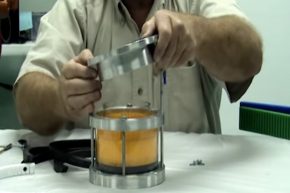GIW Makes Pump Packing Easier with New Device
 At GIW, we’re committed to making every stage of pump maintenance easy to learn, easy to complete, and safe. We accomplish this with the help of expert engineers and useful tools that give our customers greater insight into their pumps’ inner workings. One area of focus is pump packing: a process that, while simple enough on paper, can have significant consequences if done incorrectly. That’s why we’ve introduced a handy tool that helps our customers learn how to properly install packing rings.
At GIW, we’re committed to making every stage of pump maintenance easy to learn, easy to complete, and safe. We accomplish this with the help of expert engineers and useful tools that give our customers greater insight into their pumps’ inner workings. One area of focus is pump packing: a process that, while simple enough on paper, can have significant consequences if done incorrectly. That’s why we’ve introduced a handy tool that helps our customers learn how to properly install packing rings.
Pump Packing 101
Every pump operator will know that packing must be replaced at regular intervals to prevent excess leakage. Properly installed packing equally distributes the sealing force, which allows the pump’s stuffing box to separate the rotating and non-rotating parts within the shaft. When the packing rings are sufficiently worn, they should be removed and replaced.
Since it is impossible to see inside the packing area, some steps of this process are easier said than done. For example, without a visual reference, operators may struggle to confirm that packing rings have seated correctly. If the process has been completed incorrectly, the rings may burn and glaze, which can lead to long-term problems.
Training our customers
In response, GIW employs a device designed by SEPCO to allow customers to visualize and master the packing process before doing the real thing. This is a clear, acrylic device that allows operators to see how each ring is set and compressed within the pump’s stuffing box. While customers should refer to their maintenance manual and bill of materials for all packing instructions, the device contextualizes those instructions for new understanding.
To use the device, operators lubricate and install the first packing ring as normal, then use spacers that allow the rings to load and expand properly. Operators then tighten gland bolts to compress the rings until they form an even seal. They can repeat this process for each subsequent ring, using the spacers as needed, until all rings have been installed. Once the last ring has been installed, they can loosen the gland bolts to allow the packing set to relax and expand before tightening the bolts into their final position. The exact position will depend on the type of pump used but can be determined by measuring the real pump’s external leakage rate.
Thanks to this device, our customers can see how the packing rings — when properly seated and tightened — fill the space to create an even seal. This device has proven invaluable to so many of our customers that we now incorporate it into training demonstrations for our customers and employees, as well as our maintenance course.
Long-term benefits
An additional benefit of this device is that it trains operators to recognize the signs of incorrectly installed packing before they cause problems. Because pumps are often located in obscure, hard-to-reach places, leaks are not always noticed until significant damage has occurred. The leaks that result from incorrectly installed packing usually indicate premature shaft sleeve wear; in the worst cases, the slurry can blow back into the bearing assembly and cause even more serious issues. In other words, when our customers learn to install packing with the device, they also learn how to avoid these long-term problems.
This device is just one example of our commitment to customer education. Since its introduction, the device has received rave reviews; everyone who has trained with this device has commented on how much easier it is to visualize the process. With the help of this simple visual aid, our customers come away with greater insight into how their pumps work, and greater confidence in themselves to reach new heights of production!
[cta]We hold regular hands-on training courses on pump maintenance and operation. To sign up for next year’s course, visit GIW online.[/cta]


